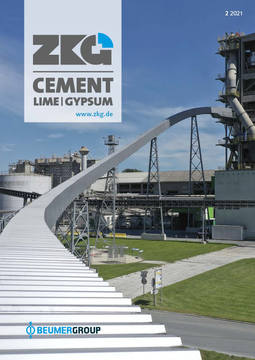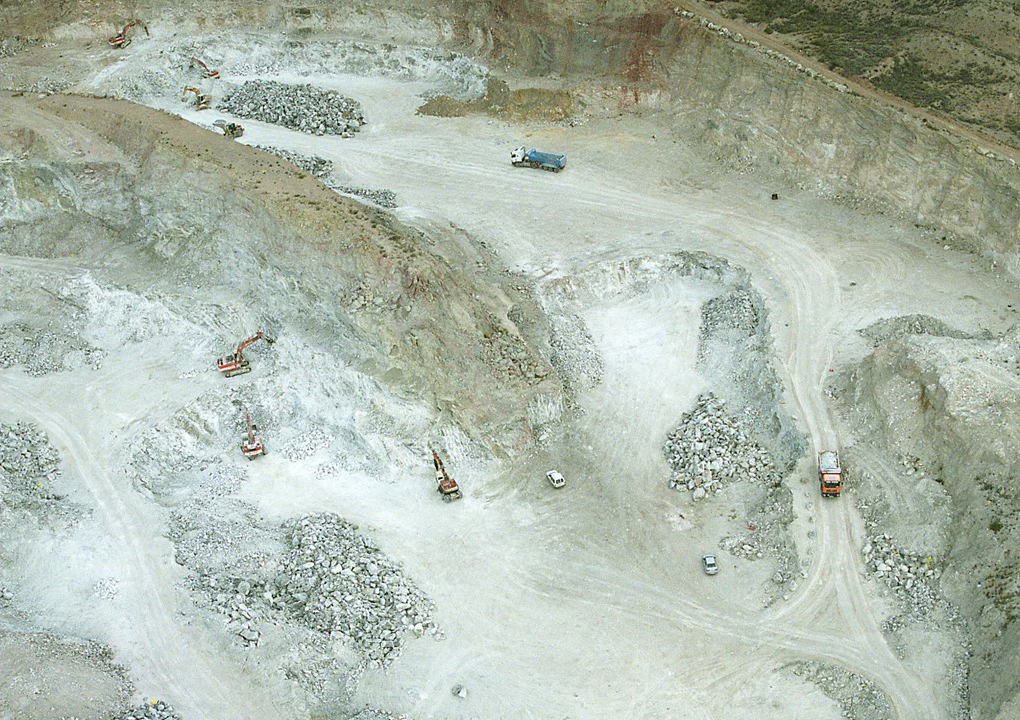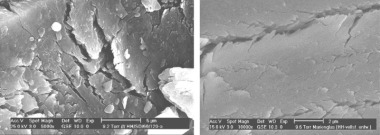Raw materials for calcium sulfate flowing screeds
Calcium sulfate flowing screeds are enjoying increasing popularity. With an overall positive growth in the floor screed mortar market in 2019 with a gain of 2% compared with 2018 the growth rate of calcium sulfate flowing screeds is higher on average than that of conventional cement floor screeds. This is due, among other things, to the advantages of this type of floor screed, which can in turn be attributed mainly to the raw materials used. This article provides details of the raw materials used for calcium sulfate flowing screeds.
One outstanding property of calcium sulfate flowing screeds is that large floor screed areas can be laid with virtually no joints in a free-flow consistency that can be placed easily and by machine. The crucial requirement for this is provided by the characteristic property of the calcium sulfate binder. It hardens with the formation of high strengths and low stresses and virtually no deformation while drying. Calcium sulfates with setting properties are now used for producing building plasters, stucco, plasterboard, gypsum wallboard and calcium sulfate floor screeds as well as modelling and moulding plasters. Calcium sulfate floor screeds can only be produced with high-strength calcium sulfate binders. In Germany they are produced using natural and industrial raw materials, which have to satisfy strict demands on quality, uniformity and long-term availability. The basis for this is created by the fact that the calcium sulfate flowing screed can actually realize its characteristic advantages during placement and in the subsequent utilization phase as an important element of the floor structure.
I. Raw material situation, acquisition, processing
The constituents of flowing screeds based on calcium sulfate can be divided into:
1. Binders
2. Additions
3. Additives
4. Aggregates
1 Binders
The binders contain calcium sulfate in various phases, such as:
natural anhydrite
alpha hemihydrate
thermal anhydrite, and
synthetic anhydrite
These calcium sulfate binders are used either alone or in mixtures with one another. These binders, together with the additions and additives, form the calcium sulfate binder.
1.1 Natural anhydrite
All the known natural gypsum and natural anhydrite deposits are of chemical-sedimentary origin. The natural accompanying minerals in natural anhydrite include those sediments that were deposited during the precipitation from the sea, such as limestone, marl, clay and sometimes also sand, bitumen and salts. The extraction of natural anhydrite for producing flowing screeds is restricted to the mining of the purest deposits. These are worked in quarries and underground. Expert assessments indicate that natural anhydrite will be available in sufficient quantities in the coming decades. Purification of the natural anhydrite to make a calcium sulfate binder consists essentially of comminution and fine grinding of the raw anhydrite that has been extracted. The requisite activators are added at the mortar mixing plants where the flowing screed is finally formulated.
1.2 Industrially produced calcium sulfates
Industrially produced calcium sulfates are generally a result of the reaction of intermediate and end products from production processes, e.g. sulphur dioxide with calcium carbonate (natural ground limestone) or calcium hydroxide (slaked lime), or of sulfuric acid with fluorspar. The calcium sulfate produced in this way is obtained either in moist, finely divided, form as calcium sulfate dihydrate (CaSO4∙2H2O) or in dry lumpy form as calcium anhydrite (CaSO4).
FGD gypsum
Gypsum from flue gas desulfurization plants (FGD gypsum) is moist, finely divided, and crystalline calcium sulfate dihydrate (CaSO4∙2H2O) with a high level of purity. It is obtained deliberately by wet flue gas desulfurization in the lime(stone) scrubbing process after oxidation with air and subsequent gypsum processing. FGD gypsum is still produced in very large quantities in Germany in power stations fired with lignite and coal. FGD gypsum will no longer be available in the long term due to the political decision to opt out of coal-based power generation and the associated closure of power stations. However, this can be covered by the adequate availability of natural gypsum, for which the underground extraction also involves less expenditure on approvals. In the form in which it is obtained as calcium sulfate dihydrate (CaSO4∙2H2O) FGD gypsum represents a product that is comparable with natural gypsum that is calcined in special plants to form a product with setting properties. The production of calcium sulfate binders with setting properties for flowing screeds using FGD gypsum as the raw material requires special processes and plants.
1.2.1 Alpha hemihydrate
Alpha hemihydrate (CaSO4∙0.5H2O) is a very reactive, high strength, binder that is capable of reacting with water within a very short time without any activator. In contrast to the calcium sulfate binders based on anhydrite the workability time in this case is controlled by setting retarders.
1.2.3 Thermal anhydrite
Thermal anhydrite is produced in a burning process (calcination) in which the water of crystallization in FGD gypsum is completely expelled and the surface area of the anhydrite (CaSO4) formed in this way is reduced to a favourable mixing water requirement by sintering.
1.2.2 Synthetic anhydrite
Synthetic anhydrite is obtained as a co-product in the production of hydrofluoric acid. The starting materials for the production of hydrofluoric acid are sulfuric acid and fluorspar, a mineral with a colouring that also affects the subsequent colour of the synthetic anhydrite.
2 Additions
Additions are admixtures that the producer can add to the calcium sulfate binder or mortar mix to influence the chemical and/or physical properties. Examples of this are fillers, such as limestone meal, and pozzolans, such as trass meal or fly ash.
3 Additives
Additives are inorganic or organic components that are either mixed in with the binder in powder form or are added during the production of the fresh mortar mix. The quantity added is generally less than 5% relative to the amount of binder. Their chemical or physical effects, or a combination of the two, enable specific adjustments to be made to the properties of the floor screed mortar, such as consistency, workability time or hardening characteristics. Additives are divided into groups according to their main effects. Typical representatives are activators, such as potassium sulfate or Portland cement, retarders based on fruit acids, superplasticizers based on melamine or naphthalene sulfonate and stabilizers based on synthetic, fermented or natural macropolymers.
The requirements for calcium sulfate binders are defined in the European standard DIN EN 13454-1 (7)
as follows:
Calcium sulfate binders (CAB) contain at least 85 mass% calcium sulfate. Calcium sulfate compo-site binders (CAC) contain at least 50 mass% but less than 85 mass% calcium sulfate. Additions, e.g. fillers, pozzolans, pigments or synthetic resins, may be added to them.
The pH of the CAB calcium sulfate binders and of the CAC calcium composite binders when mixed with water is ≥ 7.0. The start of stiffening must be ≥ 30 min and the end of stiffening must be ≤ 12 hours. The strengths of the CAB binders and of the CAC composite binders must fulfil the requirements listed in Table 1. Shrinkage and swelling of CAB and CAC lie in the range ≤ 0.2 mm/m.
4 Aggregates
Aggregates are mineral materials in the uncrushed and/or crushed state with size distributions and particle shapes that are suitable for the production of flowing screeds. Silicate materials, e.g. quartz sands, carbonate materials, e.g. limestone chippings, and sulfate materials, e.g. crushed natural anhydrite, are widely used for this purpose. Depending on the application, the particle size groups 0/2 mm, 0/4 mm and 0/8 mm with rising grading curves have proved successful. The aggregate for flowing screeds should, at the least, comply with DIN EN 13139(11) or DIN EN 13055-1(12).
II. Ecology and sustainability
The principle of sustainable building is increasingly becoming a living reality for architects, clients and planners. A sustainable building is characterized by its high ecological, economical and socio-cultural quality. The projected building is understood to be an integral system that interacts directly with our environment. It generally applies that the higher a building is rated the higher is its ecological, economical and socio-cultural value. Calcium sulfate flowing screeds represent sustainable raw material acquisition and show consideration for existing living environments with their flora and fauna. They are ecological and sustainable building materials during the entire life cycle – during production, placement and utilization. The following certification and evaluation systems have, among others, gained acceptance in Germany for the issue of sustainability:
DGNB (German Association for Sustainable Building)
BNB (Sustainable Building Evaluation System)
LEED (Leadership in Energy and Environmental Design (LEED)
These certification systems require specific production information on sustainability aspects that is processed in the form of EDPs (Environmental Product Declarations) and Environmental Supplier Declarations:
Environmental Product Declarations contain an eco-balance for a product and give detailed environmental properties. They are used for DGNB and BNB certifications
Environmental Supplier Declarations contain product information, such as recycling rate and details of regionality, and are relevant for LEED certifications
Less energy usage, lower material consumption, less packaging
Calcium sulfate flowing screeds are classified as particularly sustainable and environmentally friendly floor screed building materials because of their relatively low energy consumption in the production of the binders used. For the same performance they can be installed in thinner layers. For the same area this results in a lower material consumption and an even lower power consumption. For example, virtually only half the amount of CO2 is emitted for the production of a 35 mm thick calcium sulfate flowing screed when compared with a 45 mm thick cement floor screed.* And, flowing screeds are usually delivered to the building site as factory-mixed mortar in silos or truck mixers or in Mixmobils. This means no packaging waste.
Recycled gypsum
A research project on the subject of recycling gypsum building materials, which also covers calcium sulfate floor screeds, has been started within the framework of the “WIR” project by the Federal Ministry of Education and Research. The three fields of “Recirculation”, “Processing” and “Utilization” have to be taken into account. The amount of gypsum building material waste currently being generated is still relatively small. The recycling of the additional quantities of gypsum building material waste to be expected in the future is to be taken into account to conserve natural resources. Gypsum has the advantage that as a binder it can theoretically be used an infinite number of times in a closed loop (burning, setting, burning).




